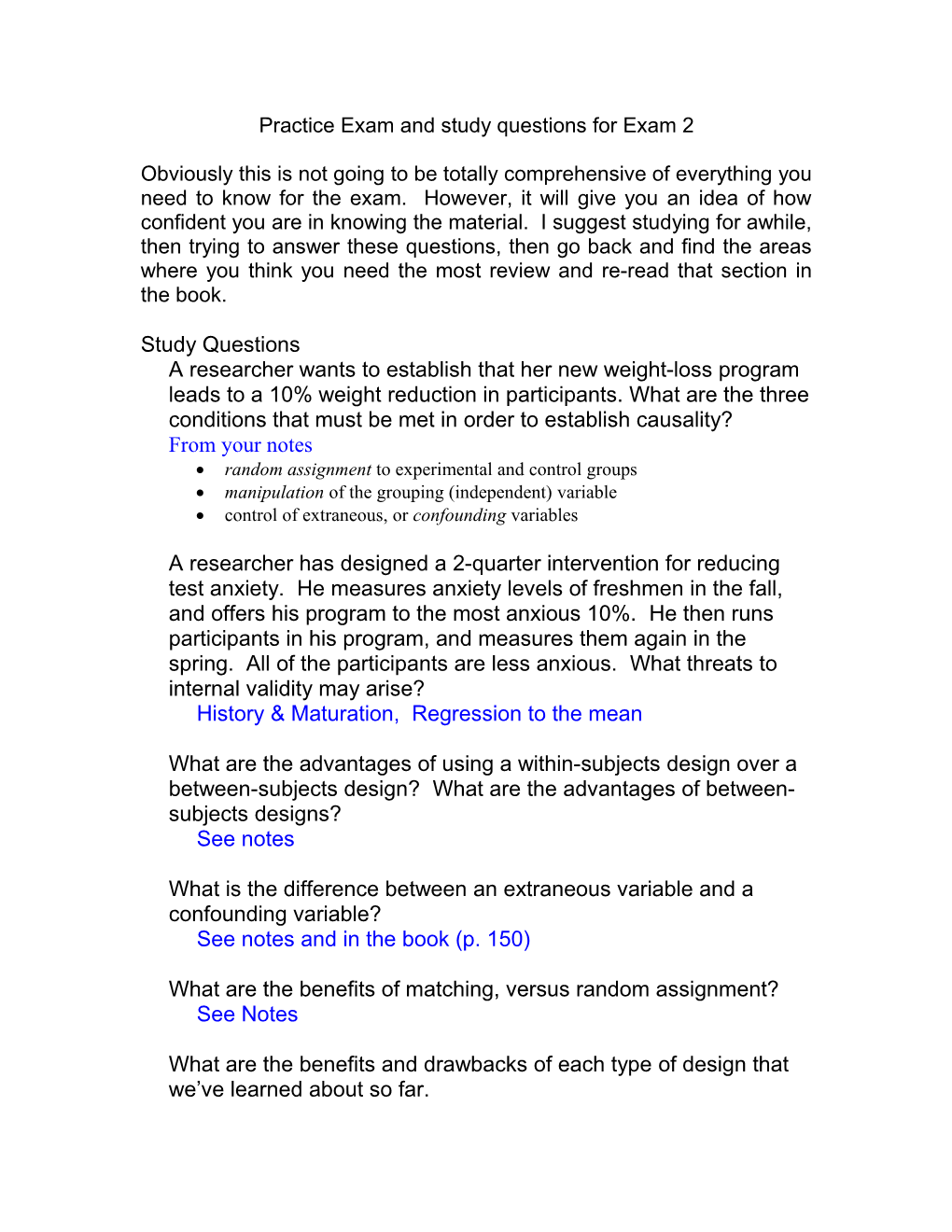Practice Exam and study questions for Exam 2
Obviously this is not going to be totally comprehensive of everything you need to know for the exam. However, it will give you an idea of how confident you are in knowing the material. I suggest studying for awhile, then trying to answer these questions, then go back and find the areas where you think you need the most review and re-read that section in the book.
Study Questions
A researcher wants to establish that her new weight-loss program leads to a 10% weight reduction in participants. What are the three conditions that must be met in order to establish causality?
From your notes
- random assignment to experimental and control groups
- manipulation of the grouping (independent) variable
- control of extraneous, or confounding variables
A researcher has designed a 2-quarter intervention for reducing test anxiety. He measures anxiety levels of freshmen in the fall, and offers his program to the most anxious 10%. He then runs participants in his program, and measures them again in the spring. All of the participants are less anxious. What threats to internal validity may arise?
History & Maturation, Regression to the mean
What are the advantages of using a within-subjects design over a between-subjects design? What are the advantages of between-subjects designs?
See notes
What is the difference between an extraneous variable and a confounding variable?
See notes and in the book (p. 150)
What are the benefits of matching, versus random assignment?
See Notes
What are the benefits and drawbacks of each type of design that we’ve learned about so far.
See notes and textbook
In a between subjects design, what is the major control issue? What do we do as researchers to address this issue?
Equivalent groups Random Assignment
In a within subjects design, what is the major control issue? What do we do as researchers to address this issue?
Order effects Matching of participants or counterbalancing
4 basic single factor designs:
Independent groups
Matched groups
Non-equivalent groups
Within subjects/repeated measures
Which of these designs use manipulated independent variables?
1, 2, 4
Be able to determine whether there are main effects or interactions between variables when given data in either a table format, or a bar graph or a line graph.
Practice exercises in class and on the website
Understand the numbering system in a factorial design
In your notes
Understand the various types of factorial designs and their characteristics
- Mixed designs
- PXE designs
- Repeated measures
- Between subjects
In your notes
Practice Exam Questions
1. In a study of students’ preferences for two colas using a within-subjects design every student tasted each cola two different times and the order of cola presentation was counterbalanced across participants. In this study, the order of cola presentation was counterbalanced in order to
a. create equivalent groups
b. control for order effects
c. avoid participant bias
d. avoid experimenter bias
2. For a consumer task comparing four brands of colas, the researcher decides to use awithin-subject design using all possible orders of the colas. In this case there will be ___ different sequences that must be represented in the study.
a.4 b. 12 c. 24d. 3
3.The hallmark of the non-equivalent group design is that
a.participants are assigned to each group using random assignment
b.these designs are not subject to any threats to internal validity
c.conclusions about the cause of behavior cannot be made
d.all of the above
4. In a correlational study examining the number of cats owned by participants and loneliness, the researcher ______the number of cats and ______the amount of loneliness that a participant has.
a. manipulates; manipulates
b. manipulates; measures
c. measures; measures
d. measures; manipulates
5. If a between-subjects design uses random assignment, the design will be called a(n)
a. nonequivalent groups design
b. repeated-measures design
c. independent groups design
d. matched groups design
6. A t test for dependent groups is used to compare experimental conditions in which of the following designs?
a. single-factor, independent groups design
b. single-factor, matched groups design
c. single-factor, nonequivalent groups design
d. both alternatives a. and c.
7. Unlike two-level designs, multilevel designs can
a. use counterbalancing
b. test more than one independent variable
c. uncover nonlinear effects
d. reject the null hypothesis
8. What is the primary difference between complete counterbalancing and partial counterbalancing?
a. whether each participant finishes the study
b. whether each participant is exposed to every condition three times
c. whether every possible condition is presented to every participant
d. whether every possible order of conditions is represented in a study
9.If exposing participants to treatment A alters their responses to a subsequent treatment B in a manner different from the alteration of the participants’ response to A when it follows B, the data suffer from
a. response fortitude
b. carryover effects
c. external invalidity
d.counterbalancing
10.The external validity of a study can be questioned with regard to
a. the longevity of the results
b. the applicability of the results to other environments
c. the generalizability of the results to other populations
d.all of the above
